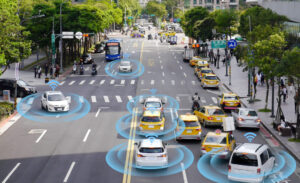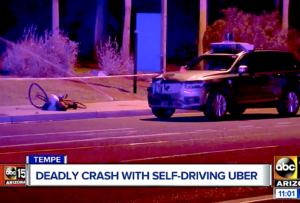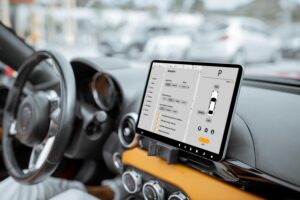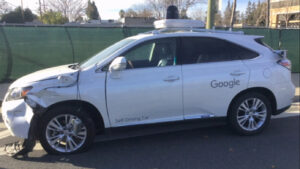Self-driving vehicles are increasingly becoming a topic of conversation in households throughout America. The question of “if” has become a question of “when.”

Photo credit: IEEE
AI (artificial intelligence) is arguably something that will define the next generation and the future of our civilization. Because of this, there are increased conversations about self-driving automobiles and their place in our current world.
What is a “self-driving” car?
A self-driving vehicle, or “autonomous car” can drive itself without human input. Self-driving vehicles employ a variety of technologies and sensors including cameras, radar, and lidar to “see” their surroundings and then make decisions about navigation.
It gets more complicated from there. Self-driving vehicles are split into levels of automation, which are defined by the Society of Automotive Engineers (SAE) and the National Highway Traffic Safety Administration (NHTSA). In fact, there is a good chance that you are unknowingly operating a vehicle with some level of automation in your own car.
What are the automation levels of a self-driving car?
The levels are as follows:
- Level 0: No automation. This is your standard vehicle in which a human operator is completely in control of the vehicle.
- Level 1: Driver assistance. Here the vehicle has some control over steering or braking, but the human operator still must be alert and ready to take over. This can include things like lane assist and automatic braking.
- Level 2: Partial automation. Here, the vehicle can control most aspects of driving, but again the driver must be alert and ready to take over.
- Level 3: Conditional automation. The vehicle can drive itself in certain conditions, but the driver still has to be ready to take over at any time.
- Level 4: High automation. The vehicle can drive itself in most conditions, a human driver isn’t needed to drive the vehicle but even here it is recommended by SAE that a human pilot remain to take over if necessary. NHTSA definitions for level 4 indicate that the human driver is not needed at all at this level.
- Level 5: Full automation. The vehicle can drive itself in all conditions and there is no need for a human driver.
As you can see illustrated in this helpful graphic created by the SAE, all but levels 4 and 5 require a human driver. To be honest, it is only at Level 5 that you truly step into what many of us would conversationally consider “self-driving.” Below, you will find NHTSA’s own graphic reflecting roughly the same information.
Are there any fully automated vehicles on our highways?
There are no “Level 5” automated vehicles driving on US highways currently. The simple fact is that the development of fully automated vehicles is still in its relative infancy. The technology has not been perfected and there are significant hurdles between where we are right now and where we need to be to have fully-automated vehicles cruising along our highways. There is also a considerable gap in legislation. We have yet to develop a safe framework for these vehicles to operate on our highways on a mass scale.
What companies are developing self-driving cars?
Many companies are currently hard at work developing Level 4 and 5 self-driving cars. This includes:
- Uber
- Tesla
- Cruise
- Waymo
You have likely heard news about the testing of self-driving cars throughout the U.S. This includes testing “robotaxi” services. Unfortunately, while developing these technologies, there have been numerous crashes and collisions. While trial and error can be expected, these incidents created setbacks in development, and have negatively affected public perception of the safety of this technology.
In August of 2023, a Cruise “robotaxi” was involved in a collision with a San Francisco fire truck that was responding to an emergency. In that collision, the Cruise vehicle had a green light but failed to recognize the duty to yield to the emergency vehicle. Interestingly, this collision occurred just a day after San Francisco leaders had asked state regulators to halt the expansion of robotaxi services in the city.
In the Cruise San Francisco collision, there were no fatalities, but one individual was transported from the scene with injuries.
Other collisions have had different and more tragic consequences. On March 18, 2018, Elaine Herzberg was killed while walking her bicycle into the roadway in Tempe, Arizona. As discussed thoroughly in a blog post by firm Shareholder Richard Armstrong, the car was an Uber self-driving vehicle with a person in the driver’s seat.
As discussed by Allen & Allen Shareholder Mic McConnell, III, there were over 400 collisions involving self-driving vehicles between 2021-2022. In those collisions, five 5 individuals were killed. Tesla vehicles accounted for nearly 70% of those crashes.

Photo credit: KNXV-TV
Are there laws regulating self-driving vehicles in Virginia?
Virginia has not been at the forefront of self-driving technology. Most of the testing and development has occurred on the West Coast. Virginia and its legislators have been very slow to recognize the growing presence of these technologies and the need to regulate self-driving cars.
Very little formal legislation exists, save for some language in the Department of Motor Vehicle guidelines, which are not legally binding. The language does provide a loose framework for companies looking to introduce their self-driving vehicles onto Virginia highways.
In a statement to Virginia Mercury, Amanda Hamm, then the Virginia Department of Transportation’s Connected and Automated Vehicle Program Manager, said, “Virginia doesn’t have anything exclusively written for AVs [automated vehicles] yet, so it’s just the current code applied to AVs.”
In essence, Virginia is currently applying the same laws to self-driving vehicles that they already apply to standard human-operated vehicles.
Is anyone regulating self-driving vehicles in the U.S.?
Federally, there is some regulation through the National Highway Traffic Safety Administration, which controls federal motor vehicle standards. Further, the National Traffic and Motor Safety Act and the Federal Motor Carrier Safety Act provide some federal safety standards for both personal and commercial self-driving vehicles. The Federal Highway Administration and the NHTSA have provided oversight and created rules and definitions for self-driving vehicles.

In summary
The idea of self-driving vehicles is exciting, but the current reality is that we have a long way to go until we have safe and reliable self-driving vehicles on our highways. Not only is the technology lacking, but it is clear that our framework of laws has a long way to go before we are at a point of safe regulation and oversight of what many consider to be the future of daily transportation.
If you have been injured in an accident, regardless of who, or what was driving the other vehicle, you have the right to talk to a lawyer who can protect your rights. The car accident lawyers at Allen & Allen are here to help. Call for a free case evaluation today at 866-388-1307.






